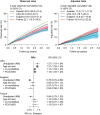Using big data from health records from four countries to evaluate chronic disease outcomes: a study in 114 364 survivors of myocardial infarction
- PMID: 29474617
- PMCID: PMC5815620
- DOI: 10.1093/ehjqcco/qcw004
Using big data from health records from four countries to evaluate chronic disease outcomes: a study in 114 364 survivors of myocardial infarction
Abstract
Aims: To assess the international validity of using hospital record data to compare long-term outcomes in heart attack survivors.
Methods and results: We used samples of national, ongoing, unselected record sources to assess three outcomes: cause death; a composite of myocardial infarction (MI), stroke, and all-cause death; and hospitalized bleeding. Patients aged 65 years and older entered the study 1 year following the most recent discharge for acute MI in 2002-11 [n = 54 841 (Sweden), 53 909 (USA), 4653 (England), and 961 (France)]. Across each of the four countries, we found consistent associations with 12 baseline prognostic factors and each of the three outcomes. In each country, we observed high 3-year crude cumulative risks of all-cause death (from 19.6% [England] to 30.2% [USA]); the composite of MI, stroke, or death [from 26.0% (France) to 36.2% (USA)]; and hospitalized bleeding [from 3.1% (France) to 5.3% (USA)]. After adjustments for baseline risk factors, risks were similar across all countries [relative risks (RRs) compared with Sweden not statistically significant], but higher in the USA for all-cause death [RR USA vs. Sweden, 1.14 (95% confidence interval 1.04-1.26)] and hospitalized bleeding [RR USA vs. Sweden, 1.54 (1.21-1.96)].
Conclusion: The validity of using hospital record data is supported by the consistency of estimates across four countries of a high adjusted risk of death, further MI, and stroke in the chronic phase after MI. The possibility that adjusted risks of mortality and bleeding are higher in the USA warrants further study.
Figures





References
-
- Schneeweiss S. Learning from big health care data. N Engl J Med 2014;370:2161–2163. - PubMed
-
- Denaxas SC, Morley K. Big biomedical data and cardiovascular disease research: opportunities and challenges. Eur Heart J Qual Care Clin Outcomes 2015;1:9–16. - PubMed
-
- Alzuhairi KS, Søgaard P, Ravkilde J, Gislason G, Køber L, Torp-Pedersen C. Incidence and outcome of first myocardial infarction according to gender and age in Denmark over a 35-year period (1978-2012). Eur Heart J Qual Care Clin Outcomes 2015;1:72–78. - PubMed
Grants and funding
LinkOut - more resources
Full Text Sources
Other Literature Sources

